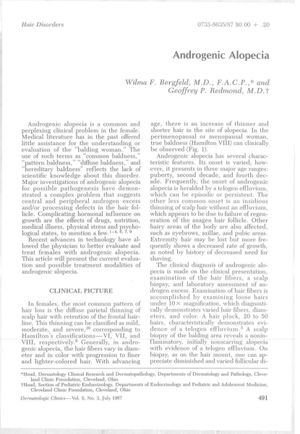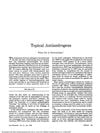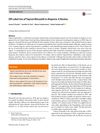Androgenic Alopecia in Females: Diagnosis and Treatment
July 1987
in “
Dermatologic Clinics
”
androgenic alopecia diffuse thinning frontal hairline scalp biopsy androgen excess adrenal gland DHEA DHEA-S hyperandrogenism alopecia androgen-secreting tumors glucocorticoids adrenal suppression spironolactone cyclic estrogen therapy topical minoxidil androgen hypersecretion androgen metabolism hair follicles endocrine abnormalities hair loss frontal hairline scalp biopsy androgen excess adrenal gland DHEA DHEA-S hyperandrogenism alopecia androgen-secreting tumors glucocorticoids adrenal suppression spironolactone cyclic estrogen therapy Rogaine androgen hypersecretion androgen metabolism hair follicles endocrine abnormalities

TLDR The document concludes that treating female hair loss should target reducing excess androgen and blocking its effects on hair follicles, with the best treatments being hormonal therapy, adrenal suppression, and topical minoxidil.
The 1987 document on androgenic alopecia in females describes the condition as hair loss with various patterns, often involving diffuse thinning but retaining the frontal hairline. It can begin at different life stages, including puberty and the decades thereafter. Diagnosis involves clinical presentation, hair examination, scalp biopsy, and assessing for androgen excess, with the adrenal gland often being the source of elevated androgens like DHEA and DHEA-S. Factors such as drugs, nutrition, and stress can also affect hair growth. Technological advances have improved evaluation and treatment, with laboratory tests identifying hyperandrogenism in 30 to 50 percent of women with the condition. The study reviewed 191 females and suggested routine hormone testing for those with alopecia. Treatments include drugs for androgen-secreting tumors, glucocorticoids for adrenal suppression, spironolactone, cyclic estrogen therapy, and topical minoxidil, which was not FDA-approved at the time. The document concludes that treatment should focus on suppressing androgen hypersecretion and blocking androgen metabolism in hair follicles, with the most acceptable therapies being cyclic estrogen therapy, adrenal suppression, and topical minoxidil, while also calling for ongoing research into endocrine abnormalities and future treatments.






